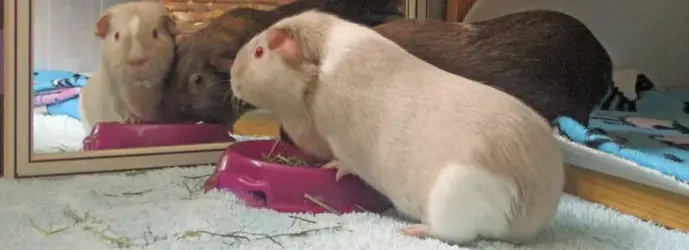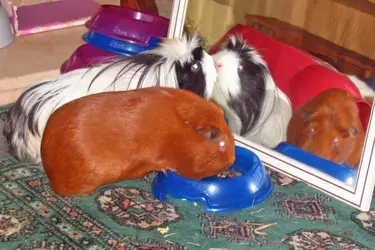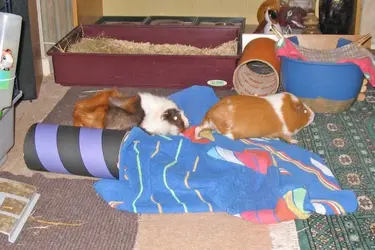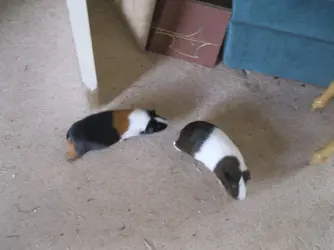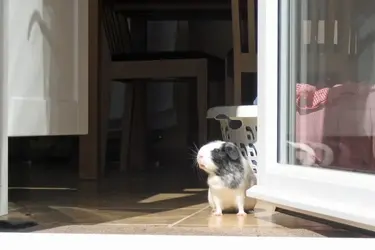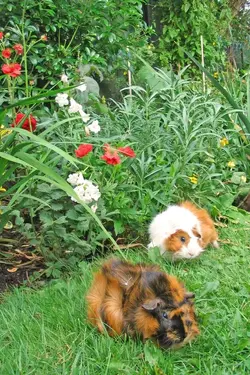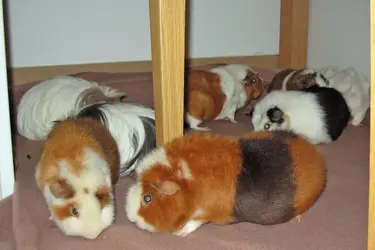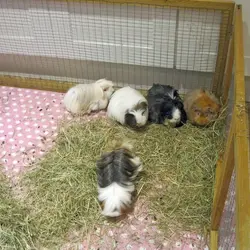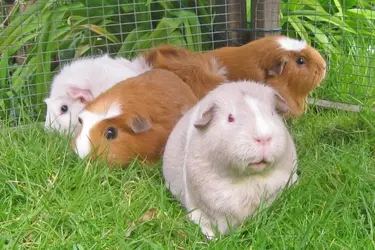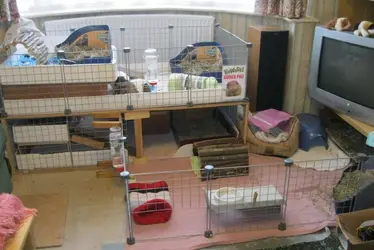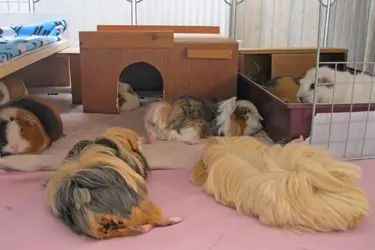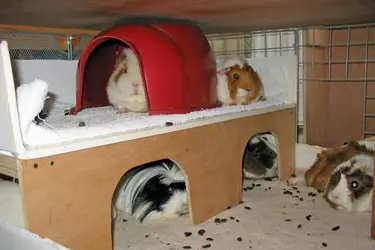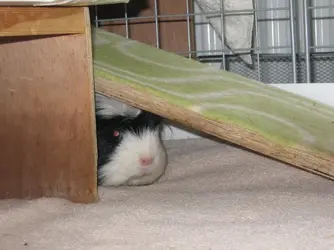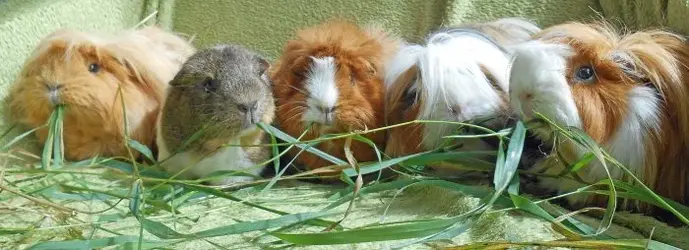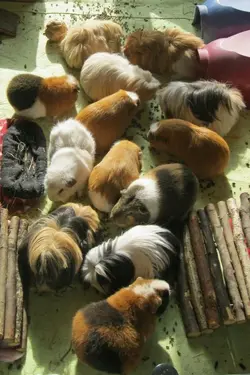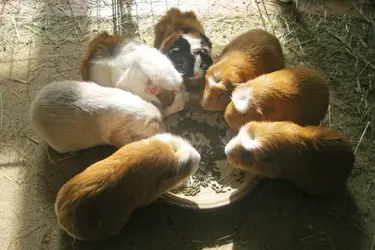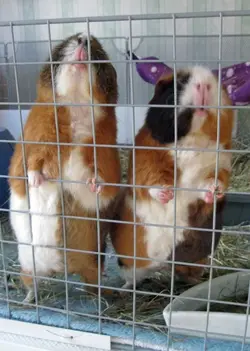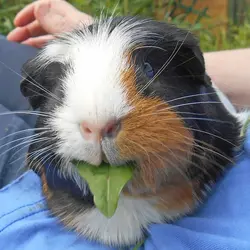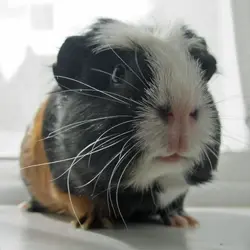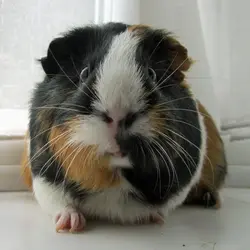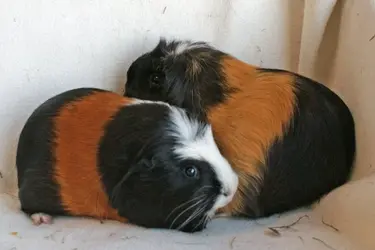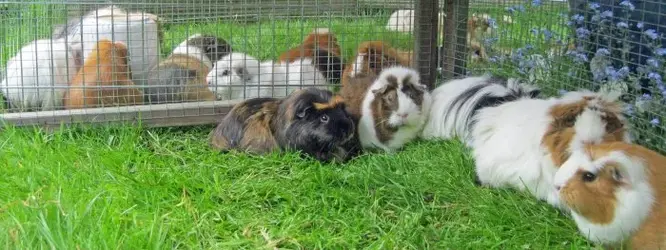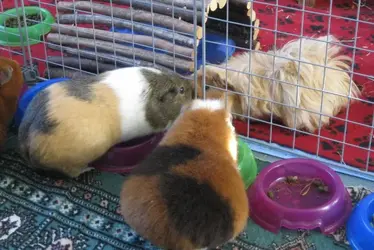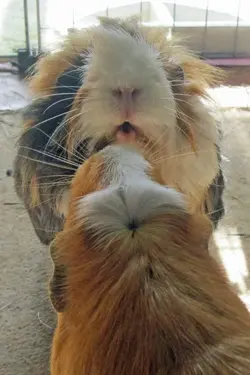7 We, the Boars
There are so many dos and don’ts and so many myths and misconceptions around our pet boars. In this instalment, I am trying to take a different look at boars – not from our owner’s side but from the species perspective in order to understand a bit better why the way we usually acquire and keep pet guinea pigs short-changes boars on several levels.
‘Bachelors’ and ‘Husboars’
Firstly, I want to go back to the ‘cavy passport’. We have looked at identity from the individual, the herd and the group perspective in the previous instalments and have found that the group is what guinea pigs identify themselves by first and foremost as their ‘nationality’.
Now I want to take a closer look at the civil status in a guinea pig passport. While in our Western society, the title of a woman has until recently distinguished her marital status as ‘Miss’ or ‘Mrs’ - but in most languages not that of a man -, this marital status distinction is in the light of cavy society much more crucial in the case of boars than with sows.
Membership of a group is not a given for boars; and in fact, in their wild ancestors, being a member of a group or not would very often be a matter of simple survival. Wild groups are generally much smaller and very hierarchical. Occasionally, a second submissive boar is tolerated in a group, but never more.
Society in domestic guinea pigs is quite different due to having to adapt to how they have been kept in larger crowds as farm animals. Group sizes can be any size, much larger than any wild herd, and can also can include any number of boars. Without access to different denning areas, group and herd have essentially merged.
However, whether a boar is a ‘bachelor’ member or a ‘husband’ who has been accepted for mating and helping to bring up his by sows still makes a huge difference in status as far as boars are concerned.
Once baby boars are weaned, their stay with their birth group would very much depend on the breeding creche group lord’s tolerance; an uncle affiliated with the core group may take on their education or they have to seek their luck elsewhere if they clash with their dad. Outside the core groups, you have the bachelor boars, who remain with the herd but are unaffiliated and are hoping for their chance to win the favour of sows of his own.
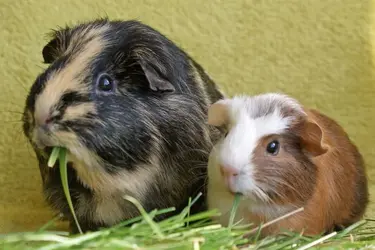 Dylan became a very caring 'uncle boar' for weaned baby Llelo to protect and teach him
Dylan became a very caring 'uncle boar' for weaned baby Llelo to protect and teach him
This doesn’t necessarily mean that bachelors are loners. Males can hang out in somewhat more informal and often more temporary associations based on their willingness to be together or hang around their original family more loosely. Often it would be group crèche members of a similar age that would naturally stick together, at least initially. This is the pattern our own pet keeping situation for boars that are not neutered essentially follows.
While it has been known that fathers even in the wild ancestor species – there are several wild guinea pig species and by far not in all of them take the dads any interest in their offspring - are involved in bringing up babies, it is now also observed that some boars are willing to look after younger boars that have left their group and to be their guardians. The ability to nurture and to form meaningful bonds and relationship is going back very far in our pet boars.
That is why some boars make such wonderful nursery nurses and teachers and why they often pine more after the loss of their long-term companion than sows, who are more strongly wired to keep the show going. And why pet boar pairs between boars of different ages (especially an adult and a baby) are often much more stable through teenage, unless there is a major clash in dominance.
However, because of the inherent rivalry in being accepted by a sow or several as the ‘husband’ or - as I prefer to call them - a ‘hus
boar’, there is always an element of competition and instability present as well. Being chosen to father the next generation (and it is the sows who choose who they want to have their offspring with) means a huge step up in status. Becoming a ‘husboar’ is nearly every boy’s dream come true.
 Dylan later in life as a husboar during bonding with his second wife Beti
Dylan later in life as a husboar during bonding with his second wife Beti
Being ripped away from a sow after mating with her and being either stuck back with their boar-mate or tucked into a breeder box on their own, is on the other hand every boy’s nightmare of a relegation in status come true – and then some people wonder why their bred boars fight as soon as they are back together again…
How does natural behaviour transfer to a pet setting?
What has really surprised me is just how aware of each other the various ‘husboars’ in the Tribe room are, and even more so my discovery that they actually have worked out a hierarchy amongst them that is independent of and overarching the individual groups in which they live. Every newly arrived boar is measured up by mutual rumble-strutting whenever the boars meet through the bars. I call this function of rumble-strutting a ‘boar haka’, a showing off of their mutual prowess. It is the peaceful way of establishing who is stronger and who is the weaker.
Consequently, while an accidental meeting on the roaming ground certainly counts as a diplomatic incident, the only bites have ever come from a boar cornered in a hut in his own cage in the course of an accidental cage invasion; and those were the instinctive defence bites of a trapped piggy and not the bites to the rump of fighting boars.
It has however also been very interesting to see that some boars can start a private feud through the bars just as well as neighbouring sows; some boars can really wind each other up. Jiggling groups around the room and making sure that any feuding groups are housed well away from each other can at times make the seating plan of a UN conference look like a doddle!
Fights for access to a group of sows do happen and fights and bullying over scant food resources are also not rare, especially in neglect situations; but in our domestic piggies, fights are usually the result of the weaker boar being unable to remove themselves from the premises in a cage setting or where boars are very evenly matched but with a shared dominant outlook.
That is also the reason why space to get away from each other is so important for boars in a pet setting. If possible, choose a cage size that can be very easily split into two welfare-compatible single cages with the help of a divider - and having that extra divider handy is something you may include in your order when buying a boar cage. Spare C&C cage grids always come in handy anyway!
It is no coincidence that the huge hormone spikes in teenage boars and young adult boars happen at a time when the more ambitious of them are starting eyeing up a career as a ‘husboar’. By far not every boar is so minded, and in fact, the majority of boars will never realise their aim. The boar vs. sow ratio in wild species is heavily tilted towards sows; meaning that bachelors will either have been driven out or pushed to the edges of the herd territory and be therefore much more vulnerable to predation when fending for their own.
Domesticated farm boars in the Andes would be generally more likely used for consumption than breeding sows, but this is not the case in the current uncontrolled mass breeding (‘hoarding’) situations that are often due to neglect or ignorance and that cause guinea pig rescues such headaches when they deal with the results. But this is also the reason why there are generally more boars in shops or in backyard breeder adverts – they are the extras...
Boars in the prime of their lives would naturally make the best of leaders, combining physical prowess with their experience. Domestication has however meant that there is usually enough food around for every piggy close to where they live and that the whole herd is living much more closely together. In a large pen or premises with lots of piggies, herd behaviour will take over from group distinction.
Pet boars – the big losers
Boars as pets can follow either the boars-only bachelor pattern (whether you create an often more stable ‘guardian and youngster’ pair’ rather than a same age ‘creche mates’ pair or the ‘husboar’ setting with one or more sows.
But it also explains why in German speaking countries the practice of baby boar castration means that they can go back to live peacefully with their family and stay with it for their whole life does work and would be a model to consider in other countries as well, as it entirely avoids most of the problems that plague pet boars and their owners elsewhere and allows safe cross gender set-ups and stable pairings with sisters right from the start of the life.
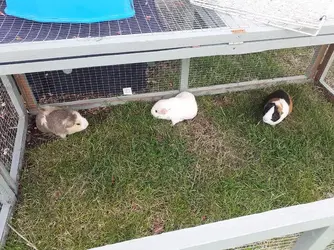 A successful boar trio bonding - chances are much better with adult and especially older boars
A successful boar trio bonding - chances are much better with adult and especially older boars
Trios and quartets are the most unstable, unless the boars have been able to choose each other. Even more so if all boys are hitting the teenage hormones at the same time in limited cage space. It is not that trios and quartets cannot work in the right conditions, it is mostly that the way we acquire piggies (babies chosen for their looks and not who they hang out with) and the way we keep them cuts right across social boar instincts and wiring as it denies them what I call ‘an amicable divorce’ with the losing boar being able to remove himself from the premises.
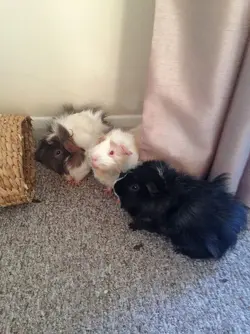 A boar trio that didn't make it
A boar trio that didn't make it
Merging two bonded boar pairs (unless they are all adult or older and are not forced into it) is very often a recipe for disaster. Just adding a baby to a bonded pair can also easily result in the bonded boar pair falling out if the stress of an unwanted bonding comes down between them and causes a fall-out. But even trying to bond a baby with a single or bereaved boar can fail if the personality match is not there – although the same adult boar may be totally in love with the next youngster he meets.
Please be aware that introducing sow pheromones into a boars-only room can really upset boars of any age, and that a spayed sow – while she won’t have any seasons – is still a sow and will usually still cause problems sooner or later when living with several boars. You are very much working against the social wiring in this case and not with it.
You need to also accept that especially in small formations like trios and quartets two neutered boars do not work out with sows; namely the dream of merging a boar pair with a sow pair – it generally won’t work out because pair dynamics differ from trio and quartet dynamics to small group dynamics with 5-7 piggies to large herd group dynamics where in the individual personality starts to be subsumed by the overall group dynamics require more piggies and ideally a very large space. The more piggies, the less important the individual personality outlook; but of course, not all piggies (especially with fear-aggressive issues and social deficits) will necessarily be suited to live in a large group.
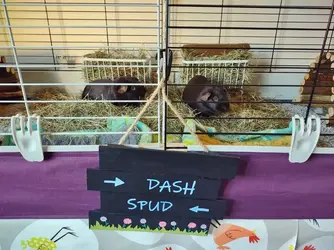 A 'can't live together but can't live without you' fallen out pair of boars who still maintain a bond through the bars
A 'can't live together but can't live without you' fallen out pair of boars who still maintain a bond through the bars
The inherent instability in pet boar bonds is largely due to two factors: The fact that boars are not allowed to choose who they want to be with and lack of cage space to have their own little territory if needed.
A common misconception I often encounter from owners with dysfunctional boar trios or quartets in large cages is that they think that space alone will prevent fall-outs. The big size doesn’t mean that there won’t be any fall-outs; what a large cage gives is the option for an ‘amicable divorce’ and the option of the losing boar to keep out of the winning boar’s territory so they do not have to fight it out with bloody bites. That is also the reason why fallen-out boars can often make a successful ‘can’t live together but can’t live apart bonded pair’ in a divided cage if there haven’t been a big bloody clash or repeated scrapping as a solution for owners who do not have the space or financial reserves for more piggies.
Rescues, especially good welfare standard privately run non-kill rescues, are doing a great job at offering rescue-born babies (if they have them) from pregnant intakes for a bonding service with bereaved, single or fallen-out boars in order to create a more stable guardian – student situation with allowing the boars to decide whether they suit or not.
It is not always a quick job; but you generally know that you are in good hands with a rescue that is insisting on a welfare compatible home and care and also keeps their rescue piggies in good conditions with strict quarantine in a separate area upon arrival, medical care and which puts up guinea pigs for adoption only when they are healthy and ready for a new home.
A look at the neutering situation
There is an increasing drive to neuter rescue boars so they can be paired up with a sow or more; especially as the majority of boars winding up in rescues and on the free-ads are typically fallen-out teenage boars at the most difficult age for re-bonding due to their all-time hormone high. Major charities like the RSPCA and the Blue Cross in the UK have switched to a neutered boars-only policy in order to cut down on accidental breeding from mis-sexing and on the big problem of unwanted fallen-out teenage boars. They offer adoption only if your boar is safely neutered (ideally 6 weeks post-op) with sows of theirs or will allow a neutered boar of theirs to live with rescue sows; many branches however won’t offer a time intensive bonding service since they are also all volunteer-run and need everybody to firstly care for the growing flood of discarded pets in today’s throw-away world.
The unique – and successful - Swiss system that doesn’t allow guinea pigs to live or to be sold/rehomed on their own entirely runs on neutered boars (mostly castrated baby boars sold via pet shops or licensed breeders) while full boars are strictly kept in tightly controlled licensed breeders’ hands. There are only rather few guinea pigs that end up in rescues and waiting lists for adoption into five-star homes only are very long.
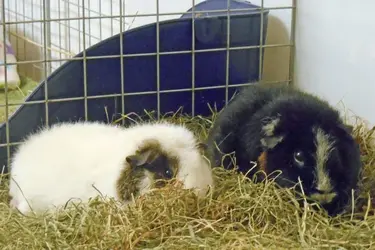
Nosgan was neutered boar bond widower who just did vibe with sows.
Young Nye became his boyfriend but went on to live (neutered) with the sow of his dreams from next door.
Boar neutering has become a much more often performed operation over the last decade; not least through the increased rescue drive. It is overall a lot more successful, with fatalities having gone down massively. Finding a good operating vet is however still key. If you are planning to have a bereaved or a fallen-out boar neutered and bonded with a rescue sow or two, you can always ask the rescue as to which vet they us since that vet will certainly have the experience and practice! It is admittedly not a cheap option and one that you may want to research first. Please always take the time but be aware that online research will majorly feature all the complications and bad outcomes and can give you a rather distorted view of the reality on the ground.
However, the many originally single, fallen-out or ‘unbondable’ Tribe ‘hus-boars’ that I have adopted over the years have definitely had the happiest of boar lives; and, of course, my current lot of de-sexed boys is still doing that.
A boar living with one or more sows is the most stable of all constellations because it comes most closely to fulfilling any boar’s career dream. Unlike with other settings, you are working with and not against natural social instincts. Again, the big hurdle at the start is acceptance – not every sow; especially not sows that have outlived their normal pup-bearing age by about 3 years are necessarily any longer interested in a boar companion. It is all down to personal outlook and mutual liking as my 5 years old Tesni proved when she fell head over heels for 5 months old gentle Gethin and had two very happy years with him.
Some rescues in the USA and in Canada prefer to de-sex sows via an ovariectomy procedure instead of boars; if you can get to one of them, you are very lucky with your bereaved or single boar! Auckland Cavy Care in New Zealand has a strict de-sexing policy for all their piggies but there are sadly no rescues in the UK with a spaying policy.
An increasing number of UK rescues is however offering an end-of-life companionship service for owners of bereaved single piggies who do not want to continue with guinea pigs where the companion will revert back to the rescue.
A warm word for boars
Boars have always been the more expendable half of the guinea pig population, and this continues until today. There are always a lot more boars around because much more sows are retained for breeding purposes whether that is commercial chain pet shop mass breeders or for sale backyard breeders (who are very much unregulated).
Since the vast majority of sales are still babies in too small cages that have been bought for cuteness and not for who they hang out with most, boars continue to be failed by humans and the human pet keeping system on all levels – it is us, the humans who are entirely to blame when it comes to the bad press for boars.
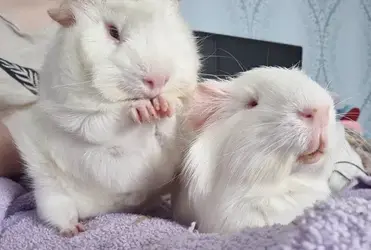
It doesn’t take a lot for you to minimise or avoid problem areas to enjoy boars – and they are very enjoyable indeed! Since boars do not have the burden of running a group and producing offspring, they are often much more personable, vocal, fun and interactive with humans. That is one big reason why I so love my Tribe ‘husboars’.
Boars also have the advantage that as they age, their hormone output is gradually winding down (but NOT their fertility) and even the worst teenagers truly mellow and become much nicer in older age. Sows were never engineered to outlive their ideal breeding age and for whom the permanent high hormone output often poses health and social issues as they get older. If you thought a teenage boar at the height of his testosterone output is hard to bond, you haven’t yet met cranky old ladies...
Practical tips for improving boar bond stability
Here is a list of points you may find helpful:
- If you can, consider adopting an already bonded pair or a mixed pair of piggies (with one parti de-sexed of course); older piggies often make the better cuddlers. Make sure that their new home carries their scent before you put them into it in order to minimise the necessary hierarchy sort-out that results from any change of territory or personnel.
- Always give boars as much space as you can spare; it really helps! Also make sure that each boar has a hut with two exits, so they cannot be cornered and fight to get out. Make sure that you have water bottles in different places and avoid sharing bowls. Sprinkling veg and pellets (only so much that they can be eaten in one sitting to encourage eating hay/grass fibre as much as possible) does not only cut down on food bullying and soiling, it also simulates natural foraging behaviour and counts as enrichment.
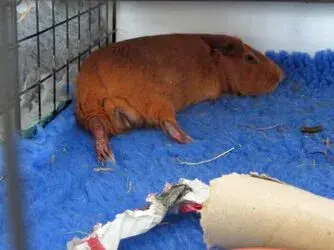
- Keep boars to pairs and do not mix them with others. Play time is always full-on bonding time as far as guinea pigs are concerned; they do not play with each other.
Boars and boar pairs can live in adjoining cages (if necessary cable-tie or put in an opaque divider if you have a feud on your hands) but unless you really have a full room; it is better to keep to pairs with any boar constellation that are not otherwise already stably bonded.
- Boar groups have more complex dynamics and therefore a higher risk of failure, which in a smaller cage can easily result in fights and fall-outs. About the same number of successful bachelor groups is outweighed by groups that end in all singles where none of the boys will go back with any of the others. Mostly you end up somewhere in the middle with one working pair and the rest singles.
- Larger bachelor groups of 10+ boars with lots of space generally work better than small groups as they function more like a larger herd group where the individual dynamics are buffered by the group. You will still need a spare space for any problems and illness, though. Like with sows, not every boar is suited for life in a big group.
- Boar pairs with an age gap (ideally one adult), father and son pairings or adult boar pairs are often more stable than same age pairs because they do not hit the teenage hormone spikes at the same time and they usually have a working natural hierarchy. But don't count on it working out without fail when the babies hit teenage!
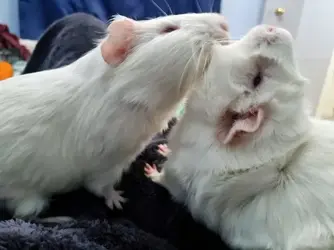
- If you can only access pet shop babies, then spend some time to look out for which boars are hanging out with each other most – they are much more likely to be friends and have a greater chance of surviving the teenage months together. More boar pairs actually make to through teenage than not but you can tweak the odds a little bit more in your favour. It all depends on the right mix of dominant and submissive personalities.
- A single boar can live next to sows for social stimulation and interaction because he has nobody in his cage to fall out with. What you need to make sure is that he cannot climb over, jump out or wiggle through any grids. Cable ties and a towel or a solid board pegged over the top of his cage along the divider should take care of any determined escape artists – especially when sows are in season!
This also works for surprise dads in mis-sexed pairs, newly separated single baby boars or bereaved boars as an emergency measure.
-When getting bonded pairs from the free-ads, please be aware that owners desperate to get rid of unwanted pets can be very economical with the truth when it comes to health and getting on. Always have a plan B (cage divider or spare cage) at the ready.
 - And please, please, please always double-check the gender of any guinea pigs you bring home!
- And please, please, please always double-check the gender of any guinea pigs you bring home!
We have a sexing guide with lots of reference pictures for different ages linked below but we also offer knowledgeable help with sexing, too, if you struggle.
Please accept that every sexing should have a hands-on component because the place where the two genders differ most are necessarily obvious with just a look at the genitalia - which is also the reason for the sadly rather rampant mis-sexing. Our aim on this forum is to teach you how you can learn for yourself how to sex guinea pigs crorrectly so you won't be again at the mercy of people who should know but sadly often don't ever again.
For more information on boars throughout the different ages, boar dos and don'ts, companionship, neutering/de-sexing and boar care aspects:
A Comprehensive Guide to Guinea Pig Boars
Boars: Teenage, Bullying, Fighting, Fall-outs And What Next?
Neutered / De-sexed Boars And Neutering Operations: Myths, Facts and Post-op Care
Boar Care: Bits, Bums & Baths
Illustrated Sexing Guide
Pictures:
Red & Brillo, Piggieminder
Pepper & Pringle, rp1993
Pepper & Percy, weepweeps
lethals Forrest & Silver2, Eriathwen
lethals Forrest & Silver ed. Eriathwen


